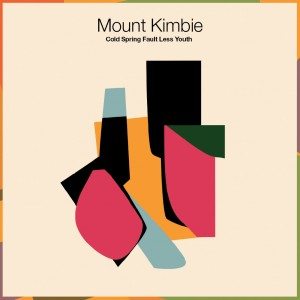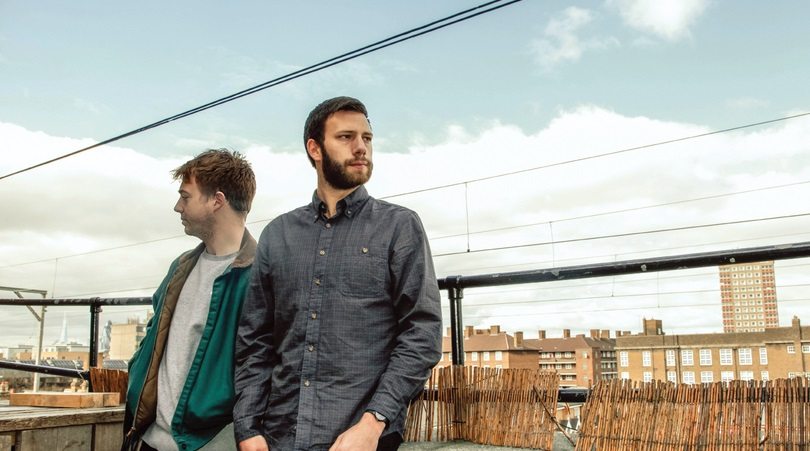Interview: Mount Kimbie
Mount Kimbie have been following me around all summer.
That’s a weird way of starting an interview piece. I’ll elaborate: the first single ‘Made to Stray’ from Mount Kimbie’s second album Cold Spring Fault Less Youth, has been following me around all summer, buzzing around my head now for months that feel like a millennia. It’s fuelled by this distinctive percussive core, that’s halfway between a heartbeat, and that strange alien chirrup you get from speakers when a signal is coming in. In a way those are both instigative forces – physical and social – equally possessing an innate compulsive force, motivating interaction, action, movement.
The peak of that irrepressible momentum for me was at this August’s Beacons Festival. Lingering at the edge of SBTRKT’s DJ-set, myself and several friends were weighing how deep to go into the crowd, not particularly pulled in by what we were hearing. Yet suddenly, ‘Made to Stray’ dropped out of nowhere. Before the sentence could even stop hanging in the air I was practically running, spontaneously driven to feel closer to the hub of where these sounds were emanating from. Yet, all the while, the song really isn’t even that danceable, certainly not specifically so.
In all these aspects ‘Made to Stray’ encapsulates a great deal of the music and nature of the artists behind it (the London-based duo Dominic Maker and Kai Campos): contradictory, complex, characterful, colourful and compelling. Catching up with Kai (before he flew off to Montenegro for the Podgorica EB Festival) gave me an opportunity to delve into such matters, and interact with other human beings. (Don’t graduate, people. It’s a terrible idea.)
 Boar Music: Hi Kai, I thought we’d kick off by talking about the album. It’s been just over three months since it was released, so how are you feeling about it now? Has performing the songs live already seen them change and develop in both performance and your estimations?
Boar Music: Hi Kai, I thought we’d kick off by talking about the album. It’s been just over three months since it was released, so how are you feeling about it now? Has performing the songs live already seen them change and develop in both performance and your estimations?
Kai Campos: Definitely, as soon as we started rehearsing we were like: “Ahh why did we not record the songs this way?!”
This is the first time where we actually got to play the songs live before recording them, but even then, we didn’t have that much to go on. At some point, I’m sure we’ll make a record where we give everything a thorough live outing before committing it all to tape. We’re really happy with how they’ve gone down in a live capacity, especially in relation to how our first album sounds live, which sometimes I’m not 100% sure of. That said, over time I’ve gotten to enjoy it more as an album.
With regards to Cold Spring, by the time we finished recording it, I was thinking: “it’s going to be Number One in the charts – it’s like a work of unadulterated genius!” Over time, however, I’ve begun to see some of the flaws in it, which is a good thing, because it does spur you to make another one.
BM: In light of that – the development of new songs and the way you feel about the first record – how are your live sets at the moment? Is your catalogue fairly balanced, with the newer set-up of live drums and such?
KC: We’ve added to it slightly, but it’s not been like a complete overhaul. I think that the old songs have adjusted, perhaps not entirely, but they’ve still been tweaked a lot. So in the live sense, the new and old fit together quite well. There are actually a couple of songs from Cold Spring which I think work better live, which has been quite a nice surprise. It’s not that the old ones didn’t work, but that we did have to change them around, but these ones naturally fit in with the live sphere.
BM: There are a couple of more aesthetic aspects of the release which have really intrigued me. First and foremost is the album title itself: Cold Spring Fault Less Youth. The meaning of the whole phrase seems to change depending on where you put the emphasis… if you have ‘fault less’ as one word, for instance. How do you say the title to people?
KC: I guess um… I don’t know! … [flatly] Cold – Spring – Fault – Less – Youth. We didn’t want to suggest anything from it so the whole point of the record title being what it is, is that it can be and mean many things… and almost contradict itself, you know. It’s like an evolving set of images. I see it almost as a very short poem: a title that doesn’t necessarily have any meaning about who we are and stuff like that.
I like the idea of not ramming stuff down people’s throats, and creating a bit of space for people’s interpretations in everything we do, from lyrics to composition and structure. We like being concise, and using not very much to say a lot.
BM: In that sense it encapsulates the way the record feels: it’s got a particularly… “itchy quality” is what I’ve got written here, although I really don’t know what I mean by that. Anyway, in the centre of the record especially, it moves and skips around a lot, as if you didn’t really want to stay in any specific mood or tact.
KC: Definitely, I think it’s disjointed in that way, and when we’re talking about it being disjointed, for us it’s not a problem at all. I think the songs came together sometime by quite a thin thread; they didn’t naturally slot next to each other and it took a few attempts to get the track listing into what it is, and we wanted the album title to kind of reflect that.
BM: The title also matches the album artwork by Leif Podhajsky. The artwork really reminds me of a Coltrane record, Coltrane Plays the Blues: a kind of late modernist abstract collage in colour.
KC: That’s interesting, because when we were talking about the album cover, we’d gone back to a lot of Impulse and Blue Notes sleeves. We sent them off to a bunch of designers, and we got a lot of direct copies, but Leif seemed to really engage with it. We sent it off with a little bit of spiel, but not too much. So when we worked with Leif we talked to him in the abstract, and then we looked at it and knew that this was the one.
BM: He also worked with you on the music video for Made to Stray’. Are there going to be any more singles from the record that would feature some of that work?
KC: I don’t know, I don’t think so. We released ‘Home Recording’ not that long ago, and after that, we felt ready to move on with ourselves. This sounds a little odd now, but I really didn’t think ‘Made to Stray’ would work as a single. Saying that, I’ve got a terrible kind of foresight with these things, and we often delegate to our manager. At the time I was all, “are you sure you want to put that one out first?”, but it turned out to be a very good decision.
BM: One remark which I’ve come across regarding your music – and this is the most complimentary of complaints – is “this song isn’t long enough”. Do you quite consciously keep your tracks to a relative brevity, or is it just the way it comes out?
KC: It’s just the way they come out, I reckon. By the end of the recording process, I genuinely thought it would be longer than our first, and was thinking “there are some epics on this!”, as if anything approaching five minutes is gargantuan. I think I like the idea of not ramming stuff down people’s throats, and creating a bit of space for people’s interpretations in everything we do, from lyrics to composition and structure. We like being concise, and using not very much to say a lot. I do think we expanded a little bit and let ourselves be more self-indulgent on this record, but we’re really quite minimal.
 BM: Perhaps what’s become most apparent as a divergence is the more organic nature of Cold Spring, of which the preponderance of your vocals is key. You seem a particularly meticulous band, so is this what pushed your desire to be more vocally active: to bring more emotion into the mix than by just using, say, samples?
BM: Perhaps what’s become most apparent as a divergence is the more organic nature of Cold Spring, of which the preponderance of your vocals is key. You seem a particularly meticulous band, so is this what pushed your desire to be more vocally active: to bring more emotion into the mix than by just using, say, samples?
KC: There were a couple of songs that came up which felt like they required a vocalist of some description. The thing about featuring other artists and musicians is that I really: a) didn’t want to have anyone guesting on this record (for fear of losing something), and b) to save ourselves from the perception that we’re just bedroom producers, knocking out beats for somebody else to sing over.
I look back at some records which feature people who can’t really sing, but are some of my favourite voices. So it wasn’t really a conscious decision at all; we got to the end of it and realised that the record had a lot of our vocals on it… which was nice! It came out of the live angle as well: we always sang more live and when we were writing the songs and playing out the half-finished versions, they quite often had vocals on.
BM: In a similar way, where are the lyrics borne from? Particularly on the songs with King Krule (Archy Marshall), there’s a particular storytelling theme. Is that something that you already had there, or was that partly your intention in bringing him to the table?
KC: We were definitely inspired by watching Archy in the studio – particularly in terms of writing lyrics – but with regards to his stuff… if we were going to have anyone guesting on the album, it had to be utilised so that they’d be fully engaged in the process. With Archy, it reached a point where he could pretty much do whatever he wanted, because we were confident that it would be what we wanted as well.
BM: You definitely get the sense of that fully collaborative atmosphere via an overarching set of themes on the album. On ‘Blood and Form’ and ‘Made to Stray’ in particular, there’s a sense of entrapment being discussed, either from behavioural traits, or in resolving to escape. Having the confidence that you can work with someone else is almost in a similar vein to that, and it sounds like you had the same experience with Leif. It’s all become very collective with the artists around you, as well as yourselves.
KC: With Archy, when we first started thinking about featuring guests on the album, he sprung to mind immediately. Even during the making of Crooks, I saw some videos of him, and found a correlation there. So when I approached him about featuring on our second album, he was very enthusiastic. I was over the moon, because it was less a case of having a guest on the record, and more of an amazing opportunity: it didn’t feel like someone “featuring”; it was very much just an incredible experience to work with him in the studio.
BM: You did that set with him on Gilles Peterson last weekend which was really great –
KC: Thanks!
BM: – and then you said that was the very first time you’d performed live together, and it seemed to work so well.
KC: [laughs] We were all bricking it! I think we’ll definitely do better performances, but it was alright in the end!
BM: I guess we ought to move on to all the promo gubbins. You’re off on a massive tour of America, with Jonwayne and D33J. What plans have you got for that tour, and what attracted you to having those two acts supporting you?
KC: I’ve been friends with D33J for a while, just through being from the same place, and so it’s going to be a lot of fun, hanging out together and getting a lot of work done. In addition, I’ve become a big fan of the way Jonwayne has developed: I’m very excited about him as a hip-hop artist because it emulates the kind of stuff I grew up with. To me, he’s someone who is quite retro in some ways, but he’s also very forward-thinking. As a lyricist, he’s one of the most exciting personalities going, so, we’re really looking forward to spending time with those guys.
Mount Kimbie are now touring America (from 22nd September – 27th October), before they return to Europe for P4K Music Festival Paris. In November, the duo will be touring the UK. Their second album, Cold Spring Fault Less Youth, is available on Warp Records.

Comments (1)